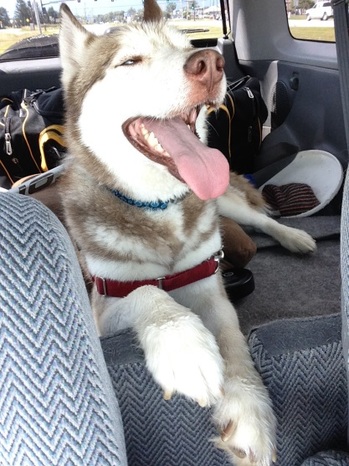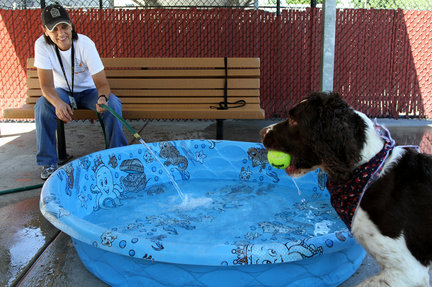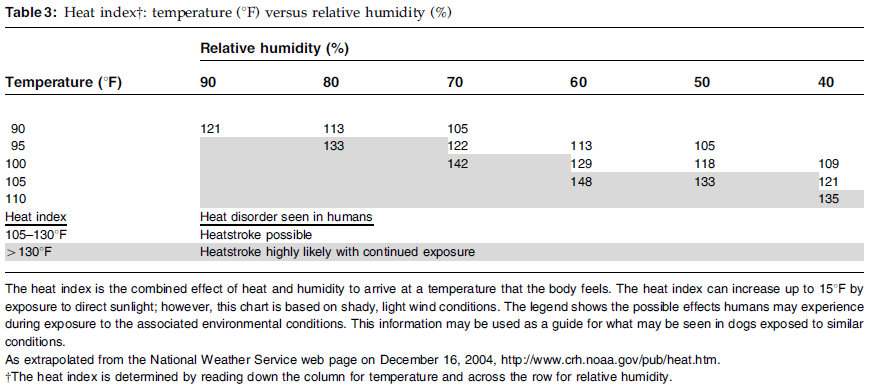Signs of Heatstroke:
- The animal may or may not have an elevated body temperature, depending on the stage of heatstroke.
- Profound depression/lethargy
- Excessive panting
- High heart rate
- Blotchy, red skin
- Reddened and dry mucus membranes
- Very rapid or nonexistent capillary refill time (CRT)
- Weak pulses
- Neurologic abnormalities such as stumbling, blindness, seizures, or coma
- Bloody diarrhea may be present or may develop during the course of treatment

Written by Natalie Morgan
4th Year Veterinary Student Extern
July 2015
Heat Stroke and Our Animal Companions
We’ve all seen the countless headlines that tell the stories of animals who suffer the dangerous effects of Mother Nature’s extreme heat, but what exactly are those effects? How can we, as animal caregivers, recognize an animal suffering from heat stroke and give them the help that they need? How can we prevent heat stroke? The following article aims to tackle these commonly encountered questions.
Introduction: When an animal’s core body temperature begins to climb, the body is normally able to counteract that increase by dissipating some of that excess heat through various mechanisms such as panting and sweating from the paw pads. Heatstroke, however, refers to the life-threatening condition in which the core temperature climbs so high and begins to have many negative effects on the body’s normal functions and regulation that the body can no longer regulate its temperature and a very serious cascade of events unfolds. Heatstroke is characterized by a core body temperature above 104 degrees F, central nervous system dysfunction (such as convulsions, confusion, or coma), and organ dysfunction. The latter two result from the cells that make up those organs getting overheated and becoming damaged, thus no longer being able to do their job. Heatstroke is more common during the summer and in hot, humid climates. Additionally, it tends to be much more common in dogs rather than cats, though has been seen in both. Animals that are outdoors during hot weather and do not have access to shade and water can all too easily develop heatstroke, as well as exercising them in hot, humid conditions. Both of these situations can commonly be encountered in a shelter setting, whether the animal was picked up as a stray on a hot day, was rescued from a hot car from which it was frantically trying to escape, or if shelter animals are walked excessively in very hot weather. If an animal presents to your shelter with a history of any of these situations, or if you are suspicious of heatstroke in an animal in your shelter on a hot day, the following is a list of signs you should look for:
4th Year Veterinary Student Extern
July 2015
Heat Stroke and Our Animal Companions
We’ve all seen the countless headlines that tell the stories of animals who suffer the dangerous effects of Mother Nature’s extreme heat, but what exactly are those effects? How can we, as animal caregivers, recognize an animal suffering from heat stroke and give them the help that they need? How can we prevent heat stroke? The following article aims to tackle these commonly encountered questions.
Introduction: When an animal’s core body temperature begins to climb, the body is normally able to counteract that increase by dissipating some of that excess heat through various mechanisms such as panting and sweating from the paw pads. Heatstroke, however, refers to the life-threatening condition in which the core temperature climbs so high and begins to have many negative effects on the body’s normal functions and regulation that the body can no longer regulate its temperature and a very serious cascade of events unfolds. Heatstroke is characterized by a core body temperature above 104 degrees F, central nervous system dysfunction (such as convulsions, confusion, or coma), and organ dysfunction. The latter two result from the cells that make up those organs getting overheated and becoming damaged, thus no longer being able to do their job. Heatstroke is more common during the summer and in hot, humid climates. Additionally, it tends to be much more common in dogs rather than cats, though has been seen in both. Animals that are outdoors during hot weather and do not have access to shade and water can all too easily develop heatstroke, as well as exercising them in hot, humid conditions. Both of these situations can commonly be encountered in a shelter setting, whether the animal was picked up as a stray on a hot day, was rescued from a hot car from which it was frantically trying to escape, or if shelter animals are walked excessively in very hot weather. If an animal presents to your shelter with a history of any of these situations, or if you are suspicious of heatstroke in an animal in your shelter on a hot day, the following is a list of signs you should look for:
Treatment of Heatstroke:
When an animal presents to a shelter with signs similar to those listed above, it is very important that the animal is seen by a veterinarian as quickly as possible. Their health should be rapidly assessed, beginning with their airway, breathing, and circulation (the ABCs). These animals may require oxygen support if it is available at your shelter. After assessing the ABCs, it is necessary to cool them down. This can be performed by anyone, and should involve spraying the animal with cool water, placing a fan in front of them, and/or placing them on a cool metal table.
It should be stressed that the use of ice should be avoided. Placing in animal in an ice water bath or using ice packs to rapidly cool the animal’s temperature results in constriction of the blood vessels in the skin and thus the animal is less able to dissipate heat from the body. In addition, contact with ice can be painful for the animal and also causes the animal to shiver, which is further increasing core body temperature. Finally, active cooling should only be performed until the animal becomes comfortable. Shivering and low body temperatures should be avoided. Further treatment after cooling the animal should be performed only by a veterinarian.
When an animal presents to a shelter with signs similar to those listed above, it is very important that the animal is seen by a veterinarian as quickly as possible. Their health should be rapidly assessed, beginning with their airway, breathing, and circulation (the ABCs). These animals may require oxygen support if it is available at your shelter. After assessing the ABCs, it is necessary to cool them down. This can be performed by anyone, and should involve spraying the animal with cool water, placing a fan in front of them, and/or placing them on a cool metal table.
It should be stressed that the use of ice should be avoided. Placing in animal in an ice water bath or using ice packs to rapidly cool the animal’s temperature results in constriction of the blood vessels in the skin and thus the animal is less able to dissipate heat from the body. In addition, contact with ice can be painful for the animal and also causes the animal to shiver, which is further increasing core body temperature. Finally, active cooling should only be performed until the animal becomes comfortable. Shivering and low body temperatures should be avoided. Further treatment after cooling the animal should be performed only by a veterinarian.
Prevention and Predisposing Factors:
Certain breeds of dogs are more predisposed to heat stroke than others. Brachycephalic dogs, or dogs with short noses such as bulldogs and pugs, have a more difficult time breathing and therefore cannot effectively dissipate heat through panting. Obesity, long hair, dark hair, old age, and very young age are also all predisposing factors for heat stroke. The following are recommendations to follow on hot days to prevent heat stroke in a shelter setting:
Certain breeds of dogs are more predisposed to heat stroke than others. Brachycephalic dogs, or dogs with short noses such as bulldogs and pugs, have a more difficult time breathing and therefore cannot effectively dissipate heat through panting. Obesity, long hair, dark hair, old age, and very young age are also all predisposing factors for heat stroke. The following are recommendations to follow on hot days to prevent heat stroke in a shelter setting:
- When the weather begins to warm up, or when moving from a colder climate to a hot and humid climate, the animal should be given time to acclimate to the new weather prior to exertional exercise.
- Provide access to water and shade at all times
- Avoid the use of muzzles
- Never leave the shelter animals in an environment in which they cannot escape heat. This includes places like parked vehicles, greenhouses, poorly ventilated garages, etc.
- Restrict exercise on hot days
- Wetting down the dogs with water or allowing them to swim can help keep them cool. Placing small swimming pools in the dog yards and keeping them full with fresh water is recommended.
- Keep the animals in air-conditioned areas as much as possible. If not, keeping fans running inside and leaving ice wrapped in a thin towel or blanket around for them to lie next to will allow them to keep cool during the day. It is important to make sure these blocks of ice are kept wrapped so that, as described above, the negative effects of direct contact with ice are avoided.

The following is a table taken from an article about heat stroke in the Journal of Veterinary Emergency and Critical Care. This table serves as a reference for shelter staff and volunteers to assist them in making decisions on walking shelter animals based on the weather. The temperature cannot be assessed by itself in order to make these decisions. One must take into account the humidity as well, and these two factors combined results in the heat index value, as shown below. These values are based off of human studies, but we can assume that animals exposed to similar conditions will suffer similar effects.
If you are ever suspicious that an animal may be suffering from heat stroke, you should always contact an emergency veterinary service near you so that the animal may receive the appropriate and prompt care that it requires. By following the suggestions outlined above, however, you can very easily assist the animal in cooling down while you await veterinary attention.
If you are ever suspicious that an animal may be suffering from heat stroke, you should always contact an emergency veterinary service near you so that the animal may receive the appropriate and prompt care that it requires. By following the suggestions outlined above, however, you can very easily assist the animal in cooling down while you await veterinary attention.
References
1. Scott I Johnson, DVM, Maureen McMichael, DVM, DACVECC and George White, DVM, DACVECC. “Heatstroke in small animal medicine: a clinical practice review.” Journal of Veterinary Emergency and Critical Care. 2006. 16(2) pp 112-119.
2. “The Prevention and Management of Heat Stroke in Dogs.”Animal Medical Center of Southern California. SDG Publishing, 2015. Accessed July 12th, 2015. http://www.animalmedcenter.com/news-and-press/article/the-prevention-and-management-of-heat-stroke-in-dogs
3. “Hot Weather Tips.” Pet Care. ASPCA , 2015. Accessed July 13th, 2015. < http://www.aspca.org/pet-care/hot-weather-tips>

